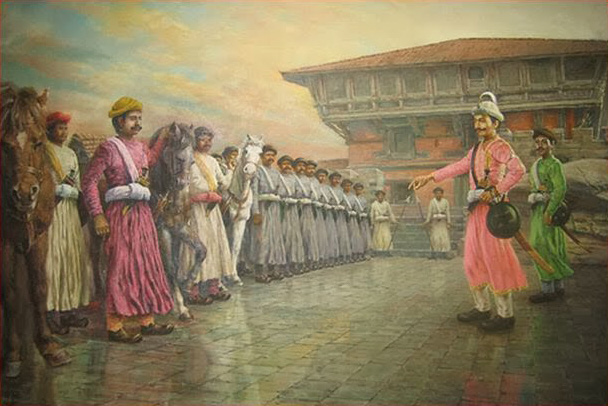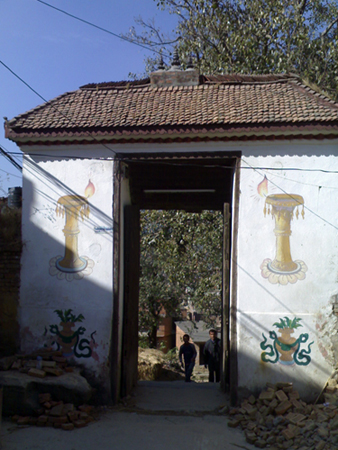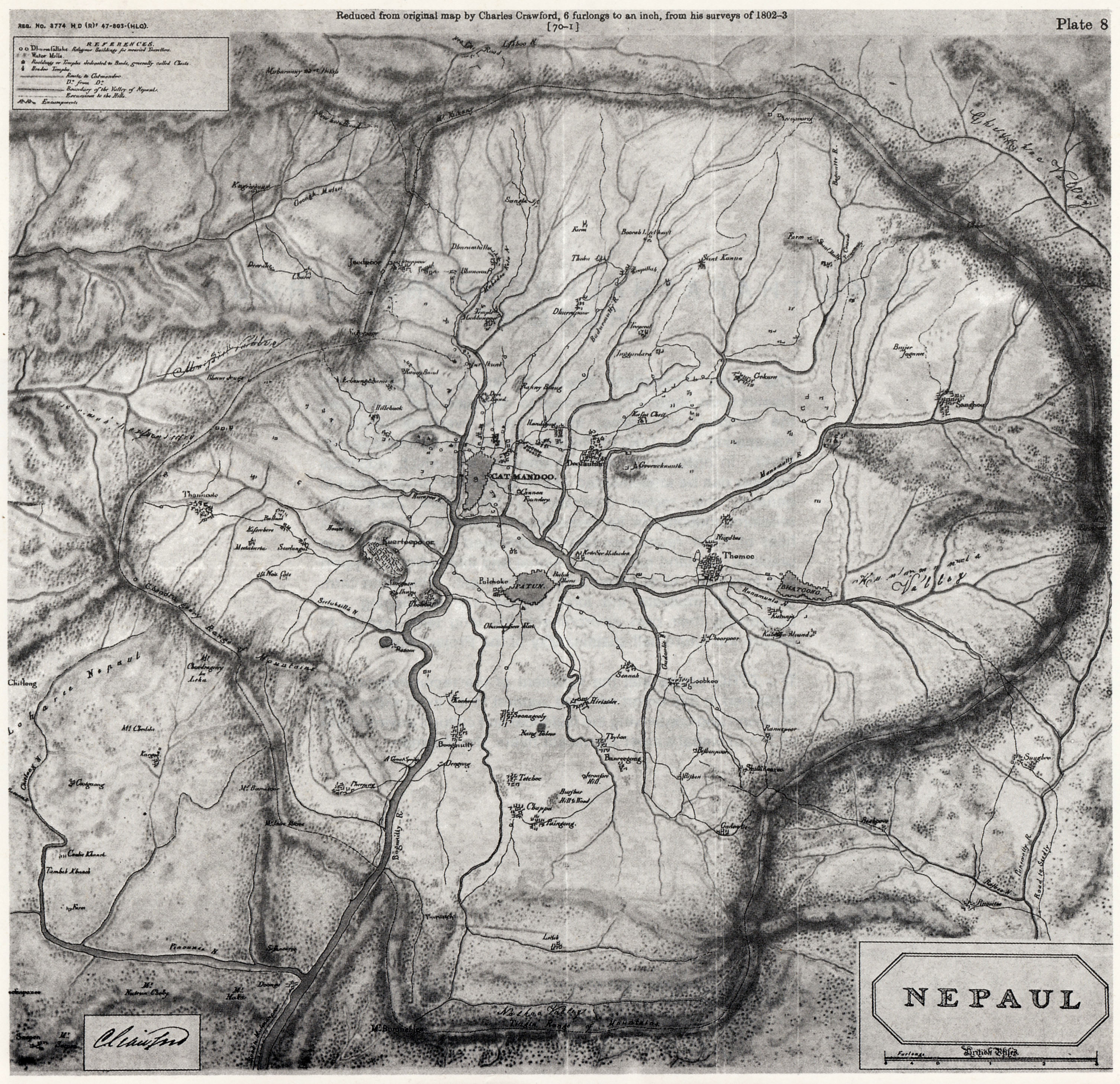|
Unification Of Nepal
The Unification of Nepal, also known as Expansion of Gorkha Kingdom, officially began in 1743 AD (1799 BS) after King Prithvi Narayan Shah of Gorkha launched an aggressive annexation campaign seeking to broaden his own kingdom's border. After conquering the Nepal Mandala, which consisted of the different city-states of the Kathmandu, Lalitpur, Kirtipur and Bhaktapur, Shah moved his hilly capital in Gorkha to the fertile and wealthy city of Kathmandu and adopted the name Nepal for the entire Gorkha Empire. The Shah dynasty would go on to expand the various warring kingdoms that once occupied parts of present-day Nepal into a nation-state that stretched up to the Sutlej River in the west and Sikkim-Jalpaiguri in the east. Before usage by the Gorkha Empire, the Kathmandu Valley was known as Nepal after the Nepal Mandala, the region's Nepal Bhasa name. Invasion of Nuwakot Prithvi Narayan Shah's annexation campaign began with the nearby kingdom of Nuwakot. Nuwakot marked the eas ... [...More Info...] [...Related Items...] OR: [Wikipedia] [Google] [Baidu] |
Kalu Pande
Vamshidhar Pande ( ne, वंशीधर पाँडे) known by Alias Kalu Pande ( ne, कालु पाँडे) was a Nepalese politician and military general who was appointed as Kaji of The Gorkha Kingdom. He was born in 1713 A.D. in Gorkha. He was the commander of the Gorkhali forces during the Unification Campaign of Nepal who died in the first Battle of Kirtipur in 1757 A.D. Pande's real name was Banshidhar Pande. He was a son of ''Kaji'' Bhimraj Pande who was minister during reign of King Prithivipati Shah of Gorkha. He was descendant of Minister of Gorkha and Dravya Shah's accomplice Ganesh Pande. He had three sons: ''Dewan Kajisaheb'' Vamsharaj Pande, Sardar Ranasur Pande and ''Mulkaji Sahib'' Damodar Pande (1st PM of Nepal). Family Pande was born in 1713 A.D to ''Kaji Bhimraj Pande''. He was a descendant of Ganesh Pande, who was the first Kaji (Prime Minister) of King Dravya Shah of Gorkha Kingdom established in 1559 A.D. The Pandes were considered as Thar ... [...More Info...] [...Related Items...] OR: [Wikipedia] [Google] [Baidu] |
Abhiman Singh Basnyat
Abhiman Singh Basnet/Basnyat ( ne, अभिमान सिंह बस्न्यात) was first Commander-in-Chief of Unified Nepal."Regmi Research Series" Author:Mahesh Chandra Regmi Abhiman Singh became the first Commander in Chief of a United Nepal after General Kalu Pande died during his second attempt to capture Kirtipur. He had participated in invasion of Makawanpur during Unification of Nepal. He commanded battles in Sino-Nepalese War as subordinate commander under Chautariya Shree Krishna Shah. He commanded and annexed Tanahun Kingdom into unified Nepal. In 1794 AD, King Rana Bahadur Shah dissolved government to overthrow Bahadur Shah of Nepal. Kirtiman was appointed as Chief (''Mul'') Kaji among the four Kajis succeeding Abhiman Singh. In 1857 B.S., he was sent to settle the area of the Kirata regional areas comprising; Pallo Kirant Limbuwan , Majh Kirant Khambuwan and Wallo Kirant , then called Kaala Banzaar. It was a great injustice to him to being sent to th ... [...More Info...] [...Related Items...] OR: [Wikipedia] [Google] [Baidu] |
Battle Of Bhaktapur
The Battle of Bhaktapur was the final campaign in the Gorkha conquest of Nepal. It took place in Bhaktapur in 1769, and resulted in the victory of the Gorkhali king Prithvi Narayan Shah, giving him control of the entire Kathmandu Valley and adjoining areas. Shah thus established the Shah dynasty in Nepal, and the rule of Newar Mallas came to an end. The defeated king of Bhaktapur, Ranajit Malla, was sent into exile in India. The blockade Bhaktapur (alternative names: Khwopa Desa ख्वप देस, Bhadgaon) was one of the three capital cities in the Malla confederacy of Nepal, the other two being Kathmandu and Lalitpur. The eastern boundary of the kingdom of Bhaktapur extended to a distance of five-six days' journey to the east. The city contained 12,000 households. The Gorkhalis desired the Kathmandu Valley due to its rich culture, trade, industry and agriculture. In 1736, the Gorkhali king Nara Bhupal Shah launched an attack on Nuwakot, a border town and fort in the ... [...More Info...] [...Related Items...] OR: [Wikipedia] [Google] [Baidu] |
Vamsharaj Pande
Vamsharaj Pande (a.k.a. Bamsa Raj Pande, Vansha Raj Pande, or Bangsha Raj Pande) ( ne, वंशराज पाँडे; translit. ''vaṃśarāja pām̐ḍe'') was a Nepalese politician, military officer and minister of state. He was a significant army commander of Kingdom of Nepal in the second half of 18th century. He was a follower of Bahadur Shah of Nepal and had a significant rivalry with Swaroop Singh Karki. Early life and family He was born as eldest son of Kaji of Gorkha Kingdom Kalu Pande in 1739 A.D. He had two brothers - Ranashur Pande and Damodar Pande. He had a sister Chitravati Pande who was married to Kaji Kehar Singh Basnyat of the noble Basnyat family. Career Vamsharaj was made a Kaji on Marwat policy in V.S. 1819 (1762 A.D.). On 20 January 1763, Vamsha Raj Pande won a battle against Mir Qasim, the Nawab of Bengal. On 14 April 1769 A.D., he was the army commander who led attack of Gorkhali side on the Battle of Bhaktapur. After consolidation of Kathmandu va ... [...More Info...] [...Related Items...] OR: [Wikipedia] [Google] [Baidu] |
Kathmandu Valley
The Kathmandu Valley ( ne, काठमाडौं उपत्यका; also known as the Nepal Valley or Nepa Valley ( ne, नेपाः उपत्यका, Nepal Bhasa: 𑐣𑐾𑐥𑐵𑑅 𑐐𑐵𑑅, नेपाः गाः)), is a bowl-shaped valley located in the Himalayan mountains in Nepal. It lies at the crossroads of ancient civilizations of the Indian subcontinent and the broader Asian continent, and has at least 130 important monuments, including several pilgrimage sites for Hindus and Buddhists. There are seven World Heritage Sites within the valley. The Kathmandu Valley is the most developed and the largest urban agglomeration in Nepal with about 5 million population. The urban agglomeration of Kathmandu Valley includes the cities of Kathmandu, Lalitpur, Budhanilkantha, Tarakeshwar, Gokarneshwar, Suryabinayak, Tokha, Kirtipur, Madhyapur Thimi, Bhaktapur, etc. The majority of offices and headquarters are located in the valley, making it the economic h ... [...More Info...] [...Related Items...] OR: [Wikipedia] [Google] [Baidu] |
Ram Krishna Kunwar
Ram Krishna Kunwar or Ramakrishna Kunwar ( ne, रामकृष्ण कुँवर; IAST: ''Rāmakr̥ṣṇa kum̐vara'') was military commander (Sardar) of Gorkha Kingdom during the Unification of Nepal at the reign of King Prithvi Narayan Shah. He was born circa 1728 AD to Ashiram Kunwar in the Kunwar family. His descendants went on to found the Rana dynasty of Nepal. He was successful general in the Unification campaign of Nepal of King Prithvi Narayan Shah. He defeated British forces at Hariharpur Gadhi on 25 August 1767. He died in Mechi Campaign in 1771 A.D. Family He was born to Ahiram Kunwar. He had only a son named Ranajit Kunwar and three grandsons; Bal Narsingh Kunwar, Balram Kunwar and Rewant Kunwar. Career King Prithvi Narayan sent Kaji Vamsharaj Pande, Naahar Singh Basnyat, Jeeva Shah, Ram Krishna Kunwar and others to defeat the forces of Gurgin Khan at Makwanpur. Ram Krishna was ordered by the King to organize the army at Makwanpur under his control. In a let ... [...More Info...] [...Related Items...] OR: [Wikipedia] [Google] [Baidu] |
Saint
In religious belief, a saint is a person who is recognized as having an exceptional degree of Q-D-Š, holiness, likeness, or closeness to God. However, the use of the term ''saint'' depends on the context and Christian denomination, denomination. In Catholic Church, Catholic, Eastern Orthodox Church, Eastern Orthodox, Anglican Communion, Anglican, Oriental Orthodox, and Lutheranism, Lutheran doctrine, all of their faithful deceased in Heaven are considered to be saints, but some are considered worthy of greater honor or emulation. Official ecclesiastical recognition, and consequently a public cult of veneration, is conferred on some denominational saints through the process of canonization in the Catholic Church or glorification in the Eastern Orthodox Church after their approval. While the English word ''saint'' originated in Christianity, History of religion, historians of religion tend to use the appellation "in a more general way to refer to the state of special holiness t ... [...More Info...] [...Related Items...] OR: [Wikipedia] [Google] [Baidu] |
Musket
A musket is a muzzle-loaded long gun that appeared as a smoothbore weapon in the early 16th century, at first as a heavier variant of the arquebus, capable of penetrating plate armour. By the mid-16th century, this type of musket gradually disappeared as the use of heavy armour declined, but ''musket'' continued as the generic term for smoothbore long guns until the mid-19th century. In turn, this style of musket was retired in the 19th century when rifled muskets (simply called rifles in modern terminology) using the Minié ball (invented by Claude-Étienne Minié in 1849) became common. The development of breech-loading firearms using self-contained cartridges (introduced by Casimir Lefaucheux in 1835) and the first reliable repeating rifles produced by Winchester Repeating Arms Company in 1860 also led to their demise. By the time that repeating rifles became common, they were known as simply "rifles", ending the era of the musket. Etymology According to the Online Et ... [...More Info...] [...Related Items...] OR: [Wikipedia] [Google] [Baidu] |
Malla (Nepal)
The Malla dynasty ( ne, मल्ल वंश:) was the ruling dynasty of the Kathmandu Valley in Nepal from 1201 to 1779. They were a Raghuvanshi dynasty who were seen as the descendants of the Licchavi dynasty. Later Malla kings also traced one section of their lineage from Nanyadeva, the founder of the Karnat dynasty of Mithila. The term ''malla'' means wrestler in Sanskrit. The first use of the word ''malla'' in the Kathmandu Valley begins from 1201. The Malla period was a golden one that stretched over 600 years, as they presided over and flourished the Newar civilization of Nepal Mandala which developed as one of the most sophisticated urban civilisation in the Himalayan foothills and a key destination in the India-Tibet trade route. Origin The Malla kings claimed descent from the Karnat dynasty of Mithila and often stylised themselves as ''Karnātvamși'', '' Raghuvamși'' or '' Suryavamși.'' Being originally Maithil themselves, the Mallas were noted for their ... [...More Info...] [...Related Items...] OR: [Wikipedia] [Google] [Baidu] |
Kathmandu Valley
The Kathmandu Valley ( ne, काठमाडौं उपत्यका; also known as the Nepal Valley or Nepa Valley ( ne, नेपाः उपत्यका, Nepal Bhasa: 𑐣𑐾𑐥𑐵𑑅 𑐐𑐵𑑅, नेपाः गाः)), is a bowl-shaped valley located in the Himalayan mountains in Nepal. It lies at the crossroads of ancient civilizations of the Indian subcontinent and the broader Asian continent, and has at least 130 important monuments, including several pilgrimage sites for Hindus and Buddhists. There are seven World Heritage Sites within the valley. The Kathmandu Valley is the most developed and the largest urban agglomeration in Nepal with about 5 million population. The urban agglomeration of Kathmandu Valley includes the cities of Kathmandu, Lalitpur, Budhanilkantha, Tarakeshwar, Gokarneshwar, Suryabinayak, Tokha, Kirtipur, Madhyapur Thimi, Bhaktapur, etc. The majority of offices and headquarters are located in the valley, making it the economic h ... [...More Info...] [...Related Items...] OR: [Wikipedia] [Google] [Baidu] |
East India Company
The East India Company (EIC) was an English, and later British, joint-stock company founded in 1600 and dissolved in 1874. It was formed to trade in the Indian Ocean region, initially with the East Indies (the Indian subcontinent and Southeast Asia), and later with East Asia. The company seized control of large parts of the Indian subcontinent, colonised parts of Southeast Asia and Hong Kong. At its peak, the company was the largest corporation in the world. The EIC had its own armed forces in the form of the company's three Presidency armies, totalling about 260,000 soldiers, twice the size of the British army at the time. The operations of the company had a profound effect on the global balance of trade, almost single-handedly reversing the trend of eastward drain of Western bullion, seen since Roman times. Originally chartered as the "Governor and Company of Merchants of London Trading into the East-Indies", the company rose to account for half of the world's trade duri ... [...More Info...] [...Related Items...] OR: [Wikipedia] [Google] [Baidu] |






